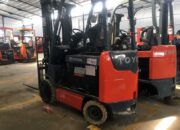Guide to Choosing Container Handling Forklifts
In the modern logistics and warehousing industry, container handling forklifts play an indispensable role. These machines optimize the loading and unloading processes, significantly saving time and labor. This article will guide you on how to the most suitable container handling forklift for your business needs, ensuring operational efficiency and safety.
Overview of Container Handling Forklifts
Container handling forklifts are specialized equipment designed to lift, lower, and transport containers in ports, warehouses, and logistics centers. They are capable of handling heavy containers, facilitating quick and efficient cargo operations. Common types of container handling forklifts include:
– Reach Stackers
– Heavy Forklifts
– Straddle Carriers
The primary advantages of using container handling forklifts include increased productivity, reduced risk of cargo damage, and optimized storage space for containers.
Factors to Consider When Choosing a Container Handling Forklift
1. Lifting Capacity: This is the most critical factor. You need to choose a forklift with a lifting capacity that exceeds the weight of the heaviest container you typically handle.
2. Maximum Lift Height: Determine the maximum stacking height for containers in your warehouse to select a forklift with appropriate lifting capabilities.
3. Engine Type: There are three main options—electric, diesel, and gas. Each type has its own pros and cons regarding operating costs, work capabilities, and environmental impact.
4. Size and Weight of the Forklift: Ensure that it fits within your workspace constraints and complies with your warehouse floor’s load-bearing capacity.
5. Safety Features: Prioritize models equipped with advanced safety systems such as collision sensors, cameras for visibility, and overload warning systems.
6. Maneuverability: Choose a forklift with a small turning radius and flexible movement capabilities to maximize efficiency in tight spaces.
7. Environmental Standards: Opt for models that meet the latest emission standards to minimize environmental impact and comply with regulations.
Assessing Usage Needs
Before making a decision, conduct a thorough assessment of your usage needs:
– Volume and Frequency of Work: Determine how many containers you need to handle daily along with their average weight.
– Working Environment: Consider whether your operations are indoors or outdoors as well as the surface type (concrete, asphalt, or dirt) to choose suitable tires and engine types.
– Operating Costs & Maintenance: Calculate fuel costs, routine maintenance expenses, and repair costs for an overview of long-term financial implications.
Comparing Brands and Models
Reputable brands in the container handling forklift market include Kalmar, Hyster, Konecranes, and Liebherr. Each brand offers unique advantages in technology, durability, and after-sales service.
When comparing different models of container handling forklifts pay attention to:
– Work performance
– Reliability & lifespan
– Fuel consumption
– Maintenance costs
– Safety features & operator comfort
Prices for container handling forklifts can range from several thousand dollars to over a million dollars depending on their capacity and features.
Steps for Selecting a Container Handling Forklift
1. Create a List of Specific Requirements: Clearly define your needs regarding capacity, lift height, working environment, and budget.
2. Research & Compare Models: Gather information from manufacturers’ websites; read reviews from users as well as industry experts.
3. Consult Experts: Reach out to dealers or consultants for detailed guidance on suitable models.
4. Inspect & Test Drive Forklifts: If possible, operate different models firsthand to evaluate performance and driving comfort.
Usage & Maintenance Tips for Container Handling Forklifts
1. Train Operators: Ensure that operators receive comprehensive training on driving techniques and safety protocols.
2. Adhere to Safety Regulations: Establish strict safety procedures within your operational area.
3. Schedule Regular Maintenance: Develop a detailed maintenance plan adhering strictly to schedules for optimal performance.
4. Monitor for Abnormal Signs: Train staff to recognize signs indicating maintenance or repairs are needed such as unusual noises or oil leaks.
Trends in Container Handling Forklifts
The forklift industry is witnessing numerous innovations:
– New Technologies: Integration of AI (Artificial Intelligence) and IoT (Internet of Things) enhances operational efficiency.
– Clean Energy: A growing trend towards electric or hybrid forklifts reduces emissions while lowering operating costs.
– Smart Management Systems: Incorporation of fleet management software helps track performance metrics effectively while planning maintenance schedules.
Conclusion
Choosing the right container handling forklift is crucial for ensuring long-term operational efficiency within your business. By carefully considering factors such as lifting capacity, working environment conditions, operating costs along with technological trends; you can make an informed decision that best suits your needs.
Remember that investing in high-quality container handling equipment will yield long-term benefits in productivity,safety,and cost savings!







